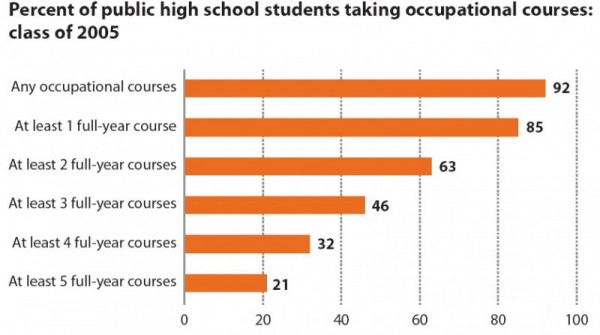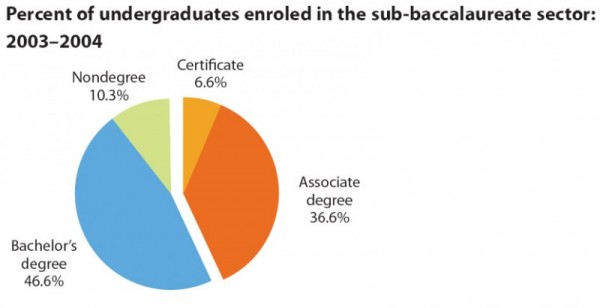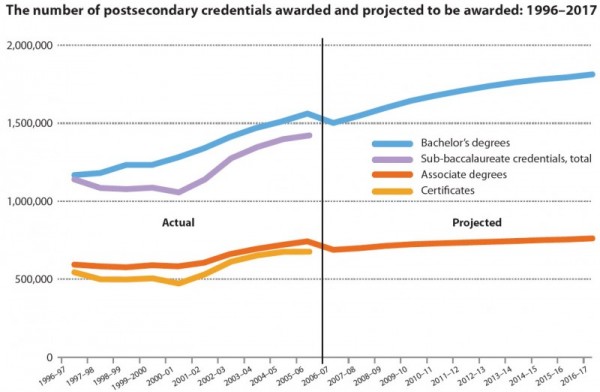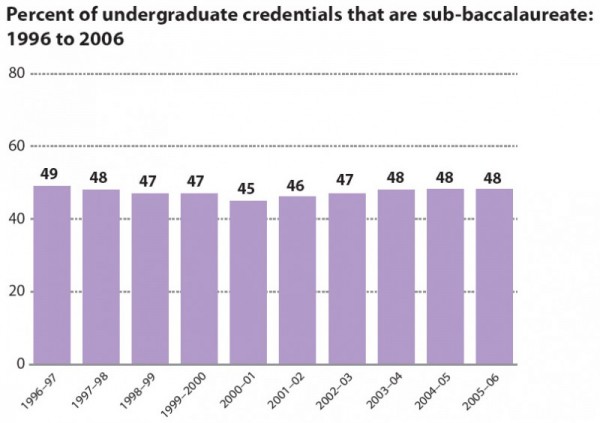Connecting Jobs to Education
Contrary to popular opinion, attaining at least a bachelor’s degree is not the only, nor in all cases the best, route to success. Nor is it the norm. Most jobs do not require a bachelor’s degree for entry, and most Americans—including most young adults—do not have a bachelor’s degree.
What makes a bachelor’s (or higher) degree so appealing is not that demand for this level of education is high, but that jobs requiring higher levels of education tend to pay more. In addition, within a job, those with higher education (at any level) tend to earn more; for example, a dental assistant with an associate degree earns about 20% more than a dental assistant who has only a high school education. However, in some jobs, particularly computer-related jobs, other forms of training and experience can substitute for a college degree. For example, although a bachelor’s degree is the entry requirement for computer systems analysts, 35% of younger analysts do not have a bachelor’s degree.
A significant number of sub-baccalaureate jobs offer better than average salary, and many of these are expected to grow. Many of these higher-paying jobs are technical or supervisory, so that although they may not require a bachelor’s degree, they do require job-specific technical training or supervisory skills. How can people get these skills? Numerous education and training opportunities (other than baccalaureate education) exist to help people train for the vast number of jobs that require only moderate amounts of training or higher education. For the sake of students and workers, it is important to acknowledge and encourage these routes to learning and labor market success. They fall into five broad categories:
- occupational (vocational) education in high school;
- sub-baccalaureate postsecondary credentials (occupational certificates and associate degrees);
- post-high-school coursetaking, from a postsecondary institution, employer, professional association, or other organization (sometimes leading to occupational certification or licensure);
- formal apprenticeship programs (federally sponsored programs that combine on-the-job training with classroom instruction);
- informal learning activities, such as seminars, web-based tutorials, and mentoring programs.
Obviously, adults can engage in more than one of these learning opportunities over a lifetime, a year, or even during a week or a day; it is not possible to say how many do so. But one hint at the size of this learning enterprise can be gleaned from a national survey of adult education, conducted by the U.S. Department of Education. For 2004-05 this survey found that 31% of all adults age 16 or older had, over 12 months, taken courses for a sub-baccalaureate degree, been in an apprenticeship program, or taken other work-related courses. Most adults also participate in informal learning activities, with estimates ranging from 75% of all employed adults to 96% of workers in establishments with at least 50 employees. Participation trends in these activities are hard to gauge, but participation in the most common of these activities—work-related course-taking—has hovered around 30% (40% for employed adults) since 2001.
Although attaining a bachelor’s degree is often (but not always) a route to higher pay—else why spend the requisite time and money?—other forms of education and training serve a broad swath of the population, including many who go on to earn relatively high salaries. These alternative learning sources should not be overlooked as important contributors to the economic success of individuals and society. Education policymakers, teachers, and guidance counselors should provide due consideration of these options for students. Rather than encouraging all students to pursue one type of education, we should encourage in all students a lifelong interest in multiple routes to learning.
Not everyone needs or will need a bachelor’s degree
About 70% of jobs require no college education for entry, and an additional 9% require only postsecondary education below the baccalaureate level. Labor market demand is changing over time, but not very quickly; the distribution of job openings in 2016 will roughly mirror the current labor market, with 69% of openings requiring no college education, and 9% requiring a sub-baccalaureate credential. In other words, twice as many new jobs will not require a bachelor’s degree as will require one.
Workers young and old eschew excess education
In line with labor market demand, about 70% of adults ages 25 to 29 do not have a bachelor’s degree. Further, only 38% of 18 to-24-year-olds are enrolled in a 4-year college.
No degree does not mean low pay
Some sub-baccalaureate jobs do offer better-than-average pay. The Bureau of Labor Statistics estimates that 360 occupations fall into this category, including high-demand jobs such as truck driver, repair and maintenance worker, carpenter, and executive secretary/administrative assistant as well as jobs in the fast-growing health and IT sectors, such radiologic technician, dental hygienist, licensed practical nurse, and computer support specialist.
Apprenticeships play small but important role
Apprenticeships make up a relatively small but important part of the training system for new workers. Only about 470,000 adults are enrolled in apprenticeship programs, but this number masks the importance of this training for job entry. In 2007, new apprentices comprised 4% of new jobs. Because most apprenticeship programs are in the construction trades, the number of apprentices tends to follow labor market demand in this area. Thus, the number of apprentices has grown in recent years, but may decline in the near future if the building industry contracts.
High schoolers value occupational courses
The formal education system serves as a training route for both job entry and lateral or upward job mobility. High school typically provides the first opportunity for job-specific training, through career/technical education offerings in occupational fields (e.g., business support, agriculture, or health science courses). The vast majority (92%) of public high school students take at least one occupational course, with 46% taking at least three such courses
Popularity of occupational courses not fading
In spite of pressures from increasing high school graduation requirements and a resulting increase in academic coursetaking, participation in occupational education has remained constant in recent years, in terms of the percent of students taking occupational courses and the average number of credits earned in these courses.
Sub-baccalaureate programs very popular
There are almost as many students enrolled in sub-baccalaureate postsecondary programs as there are in baccalaureate programs. Looking at college entry directly after high school, about 30% of recent graduates enter less-than-4-year postsecondary institutions, whereas 40% enter 4-year institutions. But the sub-baccalaureate sector is particularly likely to serve older adults, so that overall, the ratio of sub-baccalaureate to baccalaureate students is about 9 to10; about 43% of undergraduates are in sub-baccalaureate programs, compared to 47% in baccalaureate programs. (The remaining 10% are non-degree students.) Similarly, 1,422,000 sub-baccalaureate credentials were awarded in 2005-06, about 90% the number of baccalaureate credentials awarded (1,562,000).
Number of degrees has and will continue to grow
The number of sub-baccalaureate (as well as baccalaureate) credentials awarded by postsecondary institutions has increased in recent years, and is projected to increase through 2016-17, as rates of participation continue to increase.
Prominence of sub-baccalaureate degrees holds steady
At least in more recent years, sub-baccalaureate education has held its own as postsecondary participation has increased; the share of undergraduate credentials awarded at the sub-baccalaureate level has fluctuated between 45 and 49 percent since 1996-97, remaining relatively steady at about 48% since 2003-04. Projections for credential awards in future years are restricted to associate and bachelor’s degrees, and suggest that both degrees will increase in number, although associate degrees will decline slightly relative to bachelor’s degrees, dropping from 32% to 30% of undergraduate degrees. It is less clear what will happen to the market for postsecondary certificates, but these are likely to grow in the health and IT sectors.
Many degree seekers fail to finish
Left out of analyses of credential awards are adults who started but never completed a college program. Over a six-year period, about 35% of college students leave school without a credential. This percentage is higher for students who initially seek a certificate or associate degree than for those who seek a bachelor’s degree. Most of these students do not appear to be leaving because they got what they needed. Among sub-baccalaureate students, only 7% of leavers say they left because they took all the courses they wanted, whereas about half report that they left due to job, family, or financial demands. Similarly, about 45% of baccalaureate leavers report that job, family, or financial demands were the main reason they left. With so many students facing practical constraints on college completion, alternative paths to learning become even more important to ensure that all adults can develop the skills needed to remain competitive in the labor market.










